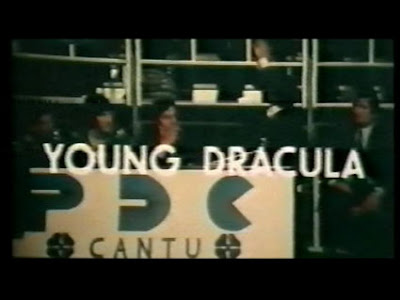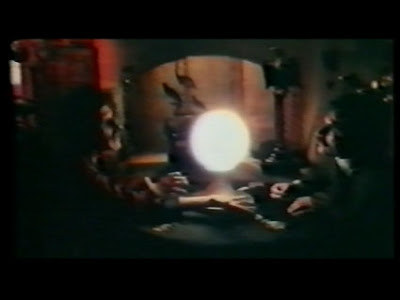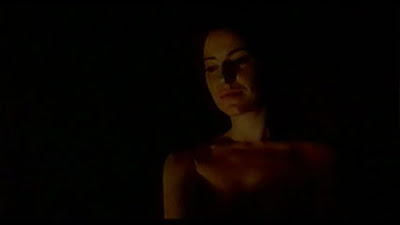In my feeble mediocrity, it’s time to present you with a list of the movies I feel made some kind of difference, stood out amongst the static or just simply affected me in one way or another during the almost passed year The most of them where released in 2011, and I’m sure that some of them where already out in 2010, but I have them in here anyway as they became accessible to me in 2011. Fred started it all off at his temple of thrills
Ninja Dixon, and
Wildside Cinema is bursting at the seams with them right now... but I can’t restrain myself to just ten movies! That wouldn't be me. I needed to squeeze forth twenty instead. I need to over do it. I over do everything, I gave you nearly 9000 characters about why
Serbian Film is so much more than "that" film, I spent almost 12000 characters to explain why the BBFC where wrong in their decision to ban
Grotesque, I've written past 100 000 characters dedicated to explaining the themes and traits of the movies of
Jean Rollin, I've spent hours making mixtapes of music from films I like... I over do it. But I'm like that with things I'm passionate about.
So, here it is, the 20+1 for 2011 list! Enjoy, don’t take the numerals as written in stone, I could push several titles up or down the scale at any given moment and watch out for flying superlatives. Oh and highlighted titles take you to the in depth reviews.

20. Rubber
This may be an strange place to start, with Quentin Dupieux’s surreal tale about a tire that possesses psychic powers, but I like when people are creative and flip tiresome genre conventions on their ass. Rubber did exactly this, and the scene when the friggin’ tire rolls up to the doorway and gawks at Roxanne Mesquida as she showers, is amongst one of the most peculiar and innovative scenes I’ve seen in ages. Not forgetting the constant breaking of the fourth wall, and that strange meta sub-plot taking place on the hillside above the town held captive by the psychic tire.

Yeah, it might be somewhat pale when held up to Soavi’s classic adaptation of Sclavi’s alternative Dylan Dog character Francesco Dellamorte. Then again it shouldn’t be compared, as this is Dylan Dog, and seen as I’ve been reading Dylan Dog since the nineties so I consider myself to be a Sclavi connoisseur, and Kevin Munroe does the source material justice. Despite hating him in the comics, I miss Groucho, but never the less Dylan Dog was a movie I looked forward to a long time and in a fun, dumb way it lived up to what I wanted it to be. I somehow feel (or wish) that the interest this movie stirred up sparked Soavi’s plan to return to genre cinema with a new Dellamorte movie.

18. Insidious.
Despite climaxing on a conventional bogus ending, I really liked most of Insidious. It grabbed me by the balls, scared me on more than one occasion and really delivered the goods in a way that almost reminded me of the first time I saw Poltergeist. An old style ghost story, with some solid scares, and it got the job done... to bad it got lost up it's own ass along the way.

17. Cold Fish [Tsumetai nettaigyo]
Sion Sono. This guy just moves from darker to darker places. There’s an uncomfortable feeling brewing from the first frame of this movie as competing fish shop owners Nobuyuki Syamoto [
Mitsuru Fukikoshi] and Yukio Murata [
Denden] paths cross after Murata manages to get Syamoto’s daughter off the hook for shoplifting. Crippled by tradition and respect, Syamoto get’s drawn into a nightmare that there’s only one-way out from. And when he comes back, he’s kicking the shit so hard that everyone’s going to feel the wrath of the frustrated underdog. A stunning movie, with glorious moments of Japanese grotesqueness and a frustration that boils within every scene.

There’s a stupid soft spot inside me for wacky genre bending musicals… I think that all of us who watch horror movies have a soft spot for these movies, that’s why we love The Rocky Horror Picture Show, The Phantom of the Paradise, The Happiness of the Katakuris and my guilty pleasure The Phantom of the Opera. Kappa, a spiteful Japanese water spirit is a reincarnation of a young man who get’s a second chance to go back to the human world and rescue the woman he always loved… and it get’s complicated. Comedic Pinku with some songs, some dances and a lot of heart sticks this one right into the list of genre benders with catchy tunes.

15. Attack the Block
I saw both Harry Brown and F., just days before watching this one, and with that in mind, it's easy to write off all hoodied kids who hang around the underpath as hoodlums. True, snot nosed kids aren’t snot nosed kids anymore. They pose a real threat that should be taken seriously, although Joe Cornish manages to make his lot somewhat sympathetic in this tale of space invaders in a British council flat. A surprising and fun movie that delivers some laughs, some shocks and nail-biting excitement, along with some awesome effects, great pop cultural referents and a brilliant Basement Jaxx soundtrack seasoned in John Carpenter sounds.

14. The Unliving [Återfödelsen]
Impressive short graduation film by Hugo Lilja tells the story of a few survivors after the zombie apocalypse. It’s more or less life as normal where the zombies have become part of it. Some work as exterminators with the intention of wiping them all off the face of the earth, some as researchers attempting to recycle them back into society, it’s just all in a days work but at polarizing sides of the spectrum. But one day the restrained living conditions come crashing down when a man finds his mother amongst the living dead. Effective, gripping and definitely a movie that gets my hopes up for Swedish genre again.

13. Trollhunter [Trolljegeren]
You can’t live in Scandinavia and not add Trollhunter on a best movies of the year list. PartBlair Witch, part Ghostbusters, part Scandinavian folk lore, this is a splendid combination and one of the funniest, most impressive and best movies to ever come out of Norway ever. And the Christian kid get’s eaten by a fucking heathen troll which proves the Vikings where right all along.

12. I Saw The Devil [Akmareul boatda]
Fuck that supernatural bullshit that was Tale of Two Sisters – I never really understood why everyone hyped that one of all the movies made at the time – and take a plunge off the deep end with Jee-woon Kim’s return to dark and haunting cynicism. Badass Serial killer vs. Good guy cop storyline done to death. But Kim has them flip roles over and over again taking them to hell and back, erasing conventional boundaries and creating one of the best narratives of this year. Byung-hun Lee and Min-sik Choi bring it all to the screen in this captivating monster of a movie. Just writing about it makes me want to watch it again.

11. We are what we are [Somos lo que hay]
Not to be confused with the elder Jorge Grau of Spain [Director of the masterpiece The Living Dead at the Manchester Morgue], but a young director from Mexico who’s debut feature is a fascinating tale of a family in turmoil after the father drops dead in the middle of a shopping mall. Now an internal struggle for dominance arises and the one who brings home the bacon will be the new patriarch… oh, did I mention that they are all cannibals? Impressive drama, high tension, dark comedy at it’s harshest.

Spanish home invasion flick Kidnapped is something of a technical masterpiece. From the way the camera flowingly moves thorough the narrative to the elaborate split screens that bring the separate feeds to shocking climaxes and the penetrating tension that the piece builds up is outstanding, this movie kicked me on my ass. Miguel Ángel Vivas twelve scenes manage to make up one hell of an impressive movie that blows the socks off a lot of other home invasion movies in the process.

Ratline, an intelligent, surprising and powerful movie that has some impressive surprises and hides some devastating punches up its sleeve. Independent filmmaker
Eric Stanze changed the way I'll watch independent genre movies this year– needless to say the bar has been raised, and every other independent filmmaker out there should be challenged by the storytelling in Ratline. A dilemma is presented here as I on one side want to scream out Give him a real big guns budget, but at the same time, low budget is where
Stanze's heart and soul is, and in all honesty he doesn't need the machinery of the cooperate bullshit slowing him down.
Stakeland holds a utopian approach to its subject matter. The same nihilism found in the zombie genre is finally seeping into the vampire genre. Gone is the pansy lovey-dovey shtick of tweeny Twilight, and back is an almost Cormac McCarthy like gloom, stinking up the earth with an engaging tale of survival against the odds… It ‘s on the list split with Ratline as Eric Stanze worked second unit on it, and I’d like to accredit a lot of the compact atmosphere to his and Ryan Samul's splendid cinematography.

I totally fell in love with The House of the Devil some years back, and I always feared the movie that Ti West would follow it up with. The horror genre is filled of one hit wonders, I really didn’t want West to become one of them. Give the guy a cigar; The Innkeepers is a fantastic movie that establishes West as a serious player in the shocker racket. This is schoolbook use of sceptics and how they bring the audience into the world of horror… and I love movies that are open to interpretation.

Powerful, raw and violent as hell, but poetically gentle, delicate and fragile at the same time, Chin-up Wong’s tale of revenge is one hell of a trip into human darkness. Posing the age-old question “what would you do in the name of love” and using the dramatic motor of emotional recognition, this movie will tear your soul apart more than any other movie has done before. Perhaps the ultimate doing bad for doing good movie, but at the same time much more than just a straightforward chop fest. Writer Juno Mak – who also plays the leading character Kit – tells a story that will leave you sick to your stomached but also with tears in your eyes as horror, thriller and a love story all come together in perfection.

6. Super 8
Yes, a mainstreamer, and a fucking brilliant one too. J.J. Abrams movie simply swept me up off my feet and made me believe in the magic of mainstream movies all over again. Everything I grew up loving about Goonies, Ghostbusters, E.T., Gremlins and Romero’s zombies was contained in this gem. Those dopey kids deliver more insight on storytelling – yeah, that movie within the movie that instigates the entire plot –than a majority of genre filmmakers out there are in their movies. I loved every minute of it, and enjoyed it just as much – if not more – on the second viewing. A movie I can watch with my kids and lure them into the darkside of genre cinema.

5. Inbred
Ok, so if I hadn’t had ever met Fred and Joachim some years back, I’d probably never had gone to the Weekend of Horrors in Bottrop, Germany, and I’d most likely never had seen Alex Chandon’s Inbred... A brilliant and unpredictable “fish-out-of-water” story about a bunch of Londoners who go up North and get what they have coming. The instant you think you are ahead of the movie it flips it head over ass and goes a complete different direction. Superb acting, great locations, and special effects proving that old school with a dab of new tech are just the ticket! Porkscratchings never tasted so good and British violence hasn’t been this grim since Carter went north.

4. Julia’s Eyes [Los ojos de Julia] *
My personal favourite of the recent Spanish “produced by the Godfather of neoGoth, Guillermo Del Toro” flicks. Finally a movie where the real threat is death, adult antagonists taking on adult protagonists and not a single fucking kiddie ghost anywhere to be seen. Definitely a homage to the Giallo genre, a play on Peeping Tom and all things that go bump in the dark. A magnificent movie that shouldn’t be missed. Belén Ruben just goes to show that you don’t need thirtysomethings pretending to be teenagers to make a scary movie; you just need fantastic actress with charisma to bring the audience into a realm of engagement, suspense and fear.

Lucky McKee’s fascinating tale of a wild woman captured by a seemingly ordinary family… but slowly, the cracks in the façade start to show, and their dysfunctional reality is exposed just in time for the grand finale. Hell hath no fury like a scorned woman, and this one packs the most bittersweet punch of them all. Following the ponce screaming about violation and what not, during Sundance, I was prepared for a regular generic torture flick. Instead I got something completely different, a mighty tour de force that floored me completely the first time I watched it. I could watch that climax for the rest of time, and if I where a chick, I'd style myself after
Pollyanna McIntosh on a daily basis.

2. Red State
I fucking love Kevin Smith. I love his movies and I even find some personal space for Jersey Girl. George Carlin is in it for christ sake and he gives a great performance. Cop Out wasn’t written by him, and just proves that he’s not a gun for hire, he needs to be in control of his stuff if he’s gonna pull it off. But then again that pay-check financed Red State, so back off. As Smith’s movies are something of an anti-thesis to the horror genre, I was terrified when he announced he was making a horror flick. I wont even tell you what I feared he’d come up with… I was wrong on all accounts. Kevin Smith delivered a brilliantly dark, provocative and satirical expose of life within a cult, and the people who want to stop them. From the horny teenagers looking for some ass to tap, to the cult members sacrificing sinners, to the mind fucking bureaucracy of the government, this is a haunting, intense and splendid movie. Smith knocked it out of the ballpark and Michael Parks deserves a goddamned academy award for his portrayal of sect leader Albin Cooper.

Yes, this is easy the best genre piece of 2011, a gripping, seductive and spellbinding masterpiece. Filled to the brim with pulpy references, and impossible to pin down or even predict where it’s going to take you. I take pride in being one of the few Swedish reviewers who wrote about this movie knowing what the referents where all about, and not just what I read on the press release. Nay, yonder Franju, Franco, Clouzot or contemporary genre imagery referrals went wasted on me Pedro. I saw them and I understood them. Almodóvar is a genius and when he dabbles in the dark side of entertainment his most diabolical movies become masterpieces. I love it when an artist shows that horror is a real genre, and not just kids geeking around with corn syrup and food dye. Horror is art, Viva Almodóvar!
There you have it, and just for the record, all titles with an apostrophe are titles that I had either poster or dvd/bluray cover quotes on. Movies that neatly sum up this great and final year of writing about genre movies in print. It’s been a life long dream come true, which now ends with the cancellation of Cinema magazine… But I have other plans for you my pretties. All will be revealed in due time.













































 Crazy Desires of a Murderer
Crazy Desires of a Murderer





 The movie looks every bit the part, cinematographer Gino Santini, gives the movie a treatment that certainly mimics the look and style much like similar, movies of the time. The corridor and cellar scenes are perhaps not originally composed when it comes to the lighting, but the shadow play of figures lurking down in the cellar is splendid.
The movie looks every bit the part, cinematographer Gino Santini, gives the movie a treatment that certainly mimics the look and style much like similar, movies of the time. The corridor and cellar scenes are perhaps not originally composed when it comes to the lighting, but the shadow play of figures lurking down in the cellar is splendid.



